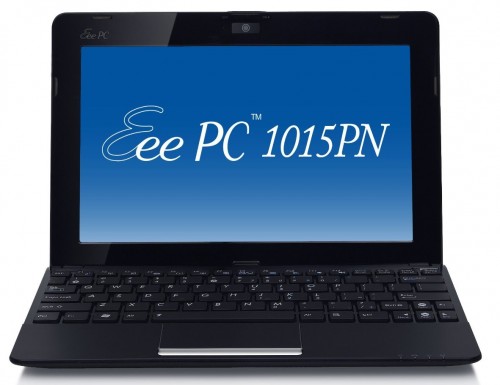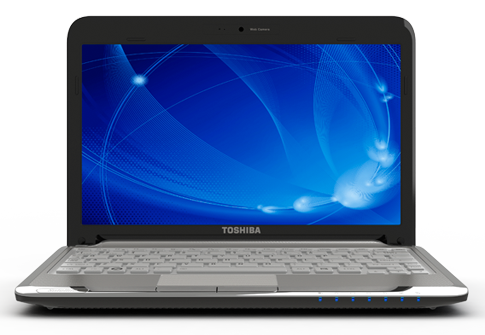Holiday Buyer's Guide: Notebooks
by Dustin Sklavos on November 15, 2010 9:00 PM EST- Posted in
- Laptops
- Guides
- Holiday 2010
Best Overall Netbook: ASUS Eee PC 1015PN-PU17 ($420)
While we don't have a whole lot of love here for Intel's Atom processor—it's dog slow and has seen virtually no evolution since its introduction—we do find there's a lot to like about its inclusion in the ASUS 1015PN.

The Eee PC 1015PN-PU17 is one of ASUS' myriad Atom-based offerings and part of their ever-growing Eee PC line, but it leverages every strength it conceivably can to produce what amounts to a sort of king of the netbooks: a dual-core Atom N550 processor coupled with NVIDIA's NG-ION graphics hardware. Naturally the netbook is Optimus-enabled, able to switch between the NG-ION and Atom's dire integrated graphics to improve battery life. The 1015PN also includes an increasingly rarefied matte screen, making it far more capable for the kind of outdoor use that netbooks should be ideal for.
If the Eee PC 1015PN has one Achilles' heel, it's battery life that comes up fairly short compared to the competition. The problem is that while it supports Optimus, you need to run the full Windows 7 Home Premium to get it... and ASUS ships the thing with Windows 7 Starter by default. Oops! So you lose dynamic GPU-switching (you can switch manually) but gain a much better netbook experience, at the cost of battery life. This is to be expected: there's a lot of extra power flowing through this system, but the payoff is in a machine that's more responsive and less aggravating to use than a basic single-core Atom netbook.
The rest of the 1015PN is bog standard for netbooks, with the usual 1GB of RAM and slow 5400-RPM hard drive. Bumping up to 2GB and Windows Home Premium will add another $100 or so to the total cost, and unfortunately ASUS continues to make it nigh impossible to actually upgrade the hard drive without tearing the system apart.
Netbook Runner Up: Toshiba T215D ($435)
If the idea of suffering through Atom in all of its glorious weaknesses doesn't sit right with you, Toshiba offers you another alternative: the AMD Nile-based T215D.

While Congo proved to be an exercise in "almost there," with Nile AMD finally proved they could bring the mayhem. The processors in this line are all derived from modern Athlon/Phenom II architecture, and they're consistently paired with the extremely capable Mobility Radeon HD 4225 integrated graphics.
What we're left with is a system that may not have the best battery life in the world (pushing just shy of five hours for typical use), but it's portable enough and gets along well enough in any other discipline. Even an NG-ION powered dual-core Atom is going to have trouble keeping up with a snappier Nile-based system, so if your usage pattern can't be squeezed into those narrow performance confines, the T215D is worth a look.
Technically some will complain that the T215D isn't a "netbook" since it uses an 11.6" chassis, but we're willing to stretch the definition. (Note that the higher spec Toshiba T235D we reviewed is larger still and sports a K325 dual-core processor in comparison to the K125 CPU in the T215D.) We wouldn't recommend any netbook as a powerful computing solution but rather as a "fast enough" alternative to Atom, and AMD's Nile offerings certainly fit that classification. The real question is whether you can live with the chromed-out silver aesthetics on the T215D.
When Portability Matters Most: ASUS 1015PED-MU17 ($326)
We've bashed on Atom performance plenty, but let's be clear: there's a niche that Atom fills perfectly well. That niche is the lightweight, inexpensive, long battery life netbook. Shop around and you can find cavalcade of similarly specced netbooks marching by, all tipping the scales at under 3lbs. and 8-10 hours of battery life, and priced to move starting at under $300. We'd recommend spending a bit more to get something with improved features and a larger battery life, though, which is why we return again to the ASUS Eee PC line. In fact, we ended up at the exact same 1015PN, this time without NG-ION. That means you keep the matte LCD but boost battery life up to 10 hours and save $100 in the process.
As an alternative to the ASUS 1015PN, you might also look at the Samsung N150-JP05 (JPxx). ASUS tends to get better battery life out of their netbooks in our testing, but the N150 also sports a matte LCD and has a different look that some will prefer over the ASUS clamshell design, and pricing starts at $300 instead of $325.










50 Comments
View All Comments
Cuhulainn - Monday, November 15, 2010 - link
Though I agree with your subject, I'd disagree with the rest. If what you say were true, you'd see high quality LCD options on every laptop, and no glossy plastic enclosures. Manufacturers will continue to make what they believe meets the needs of the market, regardless of what review sites say. Sure, they have some influence, but it's not as though their hands are tied because of these review sites.I like to have the option, especially with Optimus and the like negating power concerns. If volume and weight are concerns, there are still plenty of options without discrete GPUs.
Relax.
beginner99 - Tuesday, November 16, 2010 - link
this.And most casual gamers play on console anyway and not pc.
I would easly pic a i3 IGP + mate 16:10 screen over a discrete one with useless a glossy 16:9 screen.
But for that you need to pay the 500$ "business fee", meaning less power for a 150% price tag.
BrooksT - Monday, November 15, 2010 - link
Could you guys *be* less professional?How about "if you're willing to pay a premium for design and build quality, and accept somewhat lower performance", etc.
Calling it an "Apple tax" is as silly as talking about the "Intel tax" if you opt for a super-premium CPU. Governments impose taxes; companies offer competing value propositions.
And then you get the whole implication that you don't get anything for a tax, which takes us into the political realm.
Please, guys, grow up a bit and take Anandtech in the direction of actual journalism. It's a premium, a tradeoff, a sign of different priorities, a trap for the unwary even, but it is most certainly not a "tax" by any remotely sane definition of the word.
max347 - Tuesday, November 16, 2010 - link
This comment is ridiculous.Obviously someone is getting too old for technology. "actual journalism" is found in newspapers....which my 50 year old dad doesn't even read anymore.
"Apple tax" is a common, well-known piece of jargon. Perfectly acceptable considering the audience and medium.
If you want PC language with oldtyme verbiage and stiffly written articles, read a newspaper. I think the way these articles are presented is just fine.
Aslo though, you could start up your own tech review site, and see how that turns out. I am betting if you take the "actual journalism" route you outline, you will have every stickler and wise guy tearing apart every little mistake in an article. Presented the way they are here, readers can more comfortably approach the writers, and have more of a discussion-style look at the product in question. This is why companies send them things to review- they get feedback. With a stringent fact-article approach, I don't think you would see this level of interaction.
JonBird - Tuesday, November 16, 2010 - link
I totally agree. It was an uncharacteristically low brow comment from a site that I think of as being in the top tier of tech journalism. Aanand must not have edited this article because he would never discredit his site by using this type of non-descriptive fanboy meme.JarredWalton - Tuesday, November 16, 2010 - link
I'll just say this: I specifically asked Anand to look over the MacBook page and make any comments/edits he saw necessary. What you didn't offend him, and he uses a MacBook Pro 15 all the time. Even he will admit that you pay a significant price premium for what amounts to build quality and aesthetics, and that is the "Apple tax" so often referred to. It's such a well-known term that you can even Google definitions, and get stuff like this:http://www.pcmag.com/encyclopedia_term/0,2542,t=Ap...
Osamede - Tuesday, November 16, 2010 - link
Whatever you want to cal it - "Apple tax" is really a polite way of putting it. If someone wanted to be more provocative they could even call it an "Apple cult fee". And Even the marketing term for this: "brand premium" is itself a euphemism for commanding a price over and beyond the intrinsic value of the product when separated from the brand loyalty.A good example of this is the new Macbook Air products. Basically you have in the 11" version what is little more than an Acer 1810 encased in a shiny aluminum package with a few ounces shaven off and the price doubled. The main real value in there is the better screen and that alone cannont explain Apple's blatant price gouging on 2-3 year old CULV products.
So I would say, let them call it what they will. Apple is definitely charging more than what the products are intrinsically worth.
Spazweasel - Tuesday, November 16, 2010 - link
"Intrinsic worth" is subjective.If you add up the cost of components, you don't get to call that "intrinsic worth", because assembly isn't free. Neither is design and engineering. Many people assign no value to this, and that's just plain wrong. Apple spends more on engineering and design than most other companies, and you pay your share of it. Apple's not the "R&D and manufacturing welfare company", nor is Dell or HP or Lenovo or Asus or any other laptop maker.
You also get OS/X with your MacBook, and that's not free either (and please, no BS about "it's FreeBSD/Mach", that's a tiny part of the operating system as a whole). If you choose to throw away the OS and run something else on it, fine, but you're going to pay your amortized part of OS/X's development anyway.
Look, if you don't value where the "extra" money is going, fine, DON'T BUY IT. You're saying "if I, and only I, don't value it, it has no value to anyone and should therefore be free".
Dustin Sklavos - Tuesday, November 16, 2010 - link
Respectfully, Apple's reported profit margins border on the offensive.You would LIKE to justify the increased cost based on all the things you listed, but judging by Apple's current liquidity I'm gonna go ahead and say these things have already been paid for. The rest is just gouging the consumer.
misaki - Monday, November 15, 2010 - link
I believe you guys have the model number wrong for the 2nd asus netbook, 1015pn-mu17 doesn't exist. Your link goes to 1015ped-mu17 which has the n455.1015pem is the n550 counterpart with integrated intel gpu that has 2 versions. MU17 is cheaper by leaving out bluetooth 3.0 and has a smaller battery than PU17.
(I happened to be looking at netbooks recently)